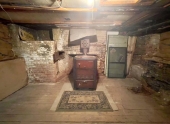
 10
10








Cargo bikes are cool
 4
4




If there is one thing the Wizard of Oz has taught me, it is not to trust school teachers on bicycles.

 3
3




Tradition is not the worship of ashes, but the preservation of fire.
 4
4




John F Dean wrote:This reminds me of the basement of the first house I ever owned. I have more questions than answers. How much moisture are you talking about? Or, to word this another way, is the moisture so bad that the repairs need to begin on the outside of the basement?
Cargo bikes are cool
 3
3




Jeremy VanGelder wrote:Do you want to insulate the wall? Or just paint it with a breathable paint?
Cargo bikes are cool






 6
6




Tradition is not the worship of ashes, but the preservation of fire.
 7
7




 4
4




Morfydd St. Clair wrote:Have you checked out the This Old House TV series? I never paid much attention to it, as my house-owning was limited to a 1950 house on the West Coast, but they specialized in older houses on the East Coast and may give you useful insights.




Jeremy VanGelder wrote:Keimfarben from Germany has been making mineral (also called water glass) paints for 150 years. They were started because German royalty wanted a paint that could be used for exterior frescoes in the harsh German environment. A number of those frescoes survive to this day.
Keimfarben
Cargo bikes are cool
 1
1




Morfydd St. Clair wrote:Have you checked out the This Old House TV series? I never paid much attention to it, as my house-owning was limited to a 1950 house on the West Coast, but they specialized in older houses on the East Coast and may give you useful insights.
Cargo bikes are cool
 2
2




Tereza Okava wrote:
Similarly- check out your local library, when I worked at one we had huge amounts of DIY books on these subjects-- and they're old enough they might be giving them away or selling them at book sales.
Cargo bikes are cool




John Daley Bendigo, Australia The Enemy of progress is the hope of a perfect plan
Benefits of rainfall collection https://permies.com/t/88043/benefits-rainfall-collection
GOOD DEBT/ BAD DEBT https://permies.com/t/179218/mortgages-good-debt-bad-debt

|
Live ordinary life in an extraordinary way. Details embedded in this tiny ad:
Rocket Mass Heater Resources Wiki
https://permies.com/w/rmh-resources
|





